The No Retreat! Series has been well received over the years since No Retreat! The Russian Front was originally published in 2008 by Victory Point Games and then republished in 2011 by GMT Games. Additions to the series have come in 2013 with No Retreat! The North African Front and in 2015 with No Retreat! Italian Front. Designed by Carl Paradis, the series tells the story of the struggles between the Allied and Axis armies during World War 2 at a player-friendly and manageable level of scope and difficulty. I have been grateful for Carl’s willingness to talk to us about his games as we have done interviews covering No Retreat! The Russian Front, Absolute War! The Attack on Russia 1941-1944 and now No Retreat 3: The French and Polish Fronts.

Grant: This is now the fourth installment (with an additional 5th currently in design) in a very successful series, what is different about No Retreat 3: The French and Polish Fronts?
Carl: First, the scale is different: it’s in-between NR1 (Russian Front, Armies/100km/2months) and NR3-NR4 (Africa-Italy, Divisions/15km/months-weeks) at 30km per hex and 3-4 Day turns, units are Corps. The short turn scale, due to the rapidity of the two Campaigns: Poland & France, is something totally different from the other games and some rules of the NR series had to be adapted for this specific campaign (but more on this later).
The other big difference is that in the other titles I was able to make the campaign start with relatively few units on the map, adding more as the game developed, which is nice when you learn the game and speeds up play immensely; in NR3, due to the historical constraints of those campaigns, you pretty much start with all your units already deployed, so you get into the “thick of things” right from the start; mind you the NR games don’t have that many counters on the board at any one time compared to the competition anyway.
Grant: How has your No Retreat! system been perfected over three separate games? What has changed the most with the system?
Carl: The rulebook in general is much clarified from the experience gained from the pervious titles, and with feedback from literally hundreds of players. Do not forget that the NR series was not started as a series but only as one single game, due to the success of NR1 I decided to add more and more games. So there is not really a “monolithic” NR game system, each ruleset will be adapted for the particular campaign being simulated. Sometimes the changes will be small, sometimes big; but a player familiar with one of the titles will be able to play a new one in no time at all.
But to answer your question, NR3 is closer to the first game of the “Series”, Russian Front, than the other two; thus will be a simpler game, mechanically. I would say that 75% of the rules are the same.

The big changes are for the Card Initiative system, and some of the combat rules. In the other games one side has the initiative for half of the game, and the other for the rest, this affects when and if event cards can be played and the way the game scoring is done (only the initiative side scores Victory Points). Not so in NR3 due to the way the campaigns historically developed. The German player keeps the Initiative for all the game, which means that most of the cards can be played for their events for the duration, if you have “Initiative” markers to pay for the card play. These initiative markers are a new concept and represent the Command & Control abilities of both sides, so there is no clear-cut “Initiative player” but each has a certain amount of Initiative “Energy” to use in various ways (each initiative markers also doubles as a combat/Movement-affecting marker).
As for the combat rules, you have extra combat tables to represent the novel “Blitzkrieg” tactics of the Germans, the more ponderous set-piece attacks of the Allies, and also Fortress Combat (the Maginot Line), you also have three different type of Tanks (Mobile, Regular and Light).

Grant: The French Front is in Western Europe and Poland is in the East. Why include them both in the same game and what do the two different conflicts benefit from in using your system?
Carl: I included both in the same game because I had the space to do so (I did the same with the Crete mini-game in NR2). I needed only half a regular-size map for the French Front game, and was able to use the other side for the Polish Front. I also had extra cards and counters. I consider those two battles to be indissociable from one another if you want to understand properly the causes of the German success against the Allies. I do not see them as “two different conflicts” at all, but as the continuation of the same conflict. It is very interesting to see the way the German Army evolved between the two battles. Plus the Polish invasion has been little-covered in wargames.
Grant: What challenges did the history of the battle for France provide for the design? How did you overcome these challenges?
Carl: The biggest challenge was to simulate properly how the Allies got beaten so badly, and what could have been done differently to stave off total defeat, while still making the game interesting to play for both sides, and the same goes for the Polish Front game. I did not want to have “Godzilla” rules that would doom the players to automatically repeat the famous German surprise Ardennes “Sickle Cut” attack; but also wanted to avoid the worst of the Historical Hindsight factor that affect immensely the way wargames are played, especially the two “Extreme Outcome” military campaign showcases simulated in NR3.

So, what I did was to add ten “Plan Cards”. Each player will randomly choose one of these cards at the start of the game, they give him some instructions you must follow at the start of the game (minimizing historical hindsight); plus three objectives you have to try to complete during the game to get extra Victory Points: but you can chose to ignore them if they don’t agree with your chosen strategy. Each Plan card corresponds to an historical Plan that was studied by the High Command of both sides, and implemented, or not. These are kept secret from your opponent. So you have a bit of historical “corset-lacing” vs. what each side can do, but not so much as players do not have a big say in their fate. Some of the said plans explore interesting historical alternatives (What if Germany attacked across Switzerland and did not attack Holland? Or the Allies planned a mobile defence?), while still keeping play-balance. Some less extreme historical alternatives are also explored in the Polish Front game, but with in-deck event cards. Mind you, you can also choose to play the Historical Game with the plans actually used by both sides.
Grant: What interesting opportunities were presented with the design?
Carl: I like challenges, and I consider that this title presented some very serious design challenges considering the decisive way Germany won both encounters. This gave me the opportunity of using the flexible NR system to show what happened historically, how things could have turned put differently (especially for the French Front), how things were not like most people think they actually were (especially for the Polish Front), and still make the “History Lesson” interesting and fun to game for both sides.
Grant: I see that you have made an exhaustive study attempt to answer the question, “Could France have staved off total defeat in 1940?” What was your final conclusion and why?
Carl: First, let me say that I don’t think that Poland could have staved off defeat in 1939. The Allies were not at all prepared, or even interested, to give Poland serious help. As for the French, they had a lot of resources but used WWI-tactics: the Germans were just too fast for them tactically and operationally. BUT if the French would have been able to better maneuver initially, and made the Germans fight on their own terms, they could have succeeded in stopping them as they did in WWI.
Grant: I am intrigued by these “Plan Cards”. How are they used and how do they effect gameplay?
Carl: As mentioned earlier, the Plan Cards give each player three historical goals to accomplish (different on each card) with each goal completed awarding the player victory points at the END of the game, but are scored at three different turns in the game. You don’t have to follow the plans, but if the games last until the bitter end (no sudden death end) those points will be very important. These cards “corset-lace” gamers a bit to represent the actual goals of both sides, but you can do otherwise if you have your own “perfect plan”, in this case try to win before the final game turn, as if your opponent has VP for his/her plans, victory could be snatched right from your grasp. Note that all the Plan goals are kept SECRET from your opponent, but a canny player could guess part of your goals, but never all.
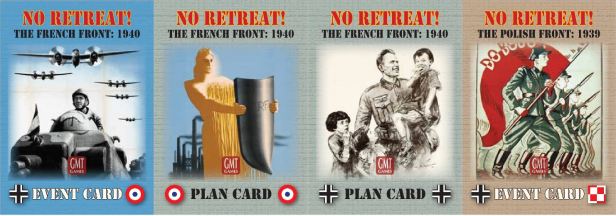
Grant: I noticed that there are several CRT’s used for different types of attacks. What are these different types and why do they need their own tables? Does this level of complexity in the combat system fill a certain thematic element you are trying to include?
Carl: The Combat and Assault tables are a bit unusual. As an attacker, the Combat tables, even at lower odds, do not make you sure of many losses (save for the occasional EX result), but you could get a CA or CR result, and that opens some interesting possibilities. It gives your opponent the option/obligation of counterattacking and possibly upsetting your position—thus making it easier for him to charge at you during his upcoming Player Turn. Or, on a CA result, your opponent might simply “pass” on the opportunity to counterattack and opt to simply play it safe and stay on the defensive. Mobile combat represents rapid attacks of mechanized forces; prepared combat a more WWI-type set-piece engagement. Fortress combat and blitzkrieg assault are more a series of “all or nothing” decisive duels, where the more casualties will be suffered compared to the other ways of attacking.
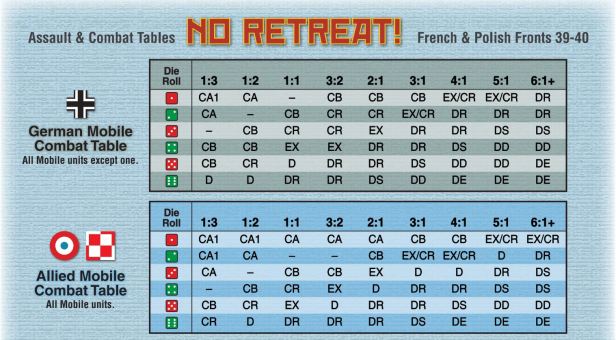
Grant: Does this level of complexity in the combat system fill a certain thematic element you are trying to include?
Carl: The combat system is similar to that of the first game, The Russian Front, but with notable differences in many of the combat results. I have spiced things up, adding more options into the Combat Tables, also added a distinction between the ponderous WWI-type combat (used by most of the Allied formations), the speedy Mobile and Blitzkrieg tactics (that the motorized units can use), and the assaults against strong fortified lines like the Maginot line, and the differences between armoured units (Blitzkrieg, Regular or Light).
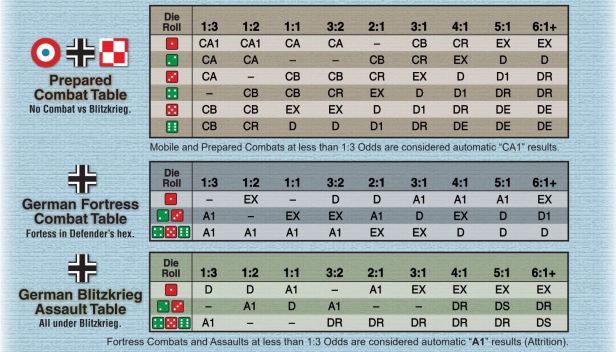
Grant: I also noticed that there are specific differences among the various sides with regards to the CRT’s. What was your aim in including these differences?
Carl: The difference is between the Allied and German Mobile Combat tables. The Allied table is weaker and the Advances after combat shorter, to show that the Allies had yet to perfect these tactics. In fact, the Leader they start with forbids them to use the Mobile table at all, unless called for by the play of event cards. Also, upon study of the two odds-based different Mobile Combat Tables, owners of the previous NR games might notice that the great German CRT results superiority in some of the other games in the series is not yet as strong, as the Wehrmacht is still learning its trade!
Grant: How are Event Cards used in the gameplay?
Carl: The Event Cards are an excellent indicator of the tactical and strategic resources a player has at his disposal. If you start your turn with a large card hand and lots of IM’s—and your opponent has few or none—then things are potentially very good for you! The cards you have in reserve represent energy you can spend, not only when using the cards’ Events (their main purpose)—but also their all-important alternate uses: paying for replacements, Counterblows, Reserve moves, evacuations, etc. With a low card count, your options are limited. Sure, one can still get by while holding only a card or two and no IM’s, but the game’s battle advantage is probably being held by the player who is holding more.
Grant: Can you show us some examples of cards and explain how they are used?
Carl: Some cards are “Must Play” and represent events out of the player’s control (ex: Bad Weather), while the rest can be played at different times in the turn, to help Combat, to Disrupt enemy units, to speed up your advance, to react to enemy moves, to activate Political events, etc… The uses are too numerous to list, but check out the samples below, the card text should be self-explanatory. Notice that even if a Card cannot be played due to lack of a specific opportunity or bad timing, they can still be used as generic “discards” to rebuild units, perform Strategic moves or Counterattacks: each card is precious. Note also that each card has two parts: one for the Germans and one for the Allies; thus both players share the same card deck, each card you have in your hand is one card event the opponent will not be used against you: this intel could be very important! Some “Must Play” cards also instruct the drawing player to give it to the opponent: this allows for some important cards to have double the chances to end up in a specific player’s hand.
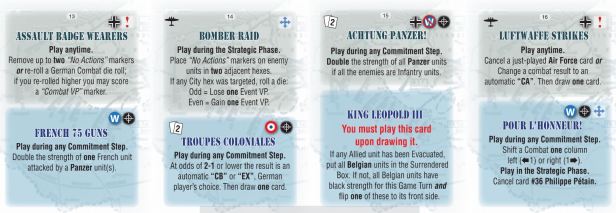
Grant: How does the game stay story-centric to the historical campaign?
Carl: Well, by the use of all the little rules gimmicks I explained previously (Leaders, Plan Cards, Event Cards). The Event Cards especially, these give historical “flair” to the game, and allows me to introduce pretty complex effects without adding pages and pages of rules to the game, making it way more dynamic and historical.
Grant: I know in No Retreat! The Russian Front there is an economic model used in the design. What is there in this version similar to that concept?
Carl: Yes and no. This is the first game of the series that does not use the full extent of the NR! “Initiative” system. Given the short length of both historical campaigns, and their outcomes, the initiative will not switch from one player to the next in middle game: it stays firmly in the German camp. The short time simulated by each game turn—days instead of weeks or months—forced me to design a new set of initiative rules. The new Initiative Markers (IM) are there for that purpose: they allow for more granularity of the original system, with each player’s resources varying from one turn to the next. The more IM’s you have, the more “in control” of the battle you will be, as you can pay for more of the powerful Event Cards, or use the markers’ backs for their special abilities. But players will notice that the more the game advances, the less cards and Initiative markers each player gets: this represent the troops are getting “used up”, the supplies depleted, so the activity will be less intense, as actually happened. In the Polish campaign the Germans almost ran out of ammo before the end of the battle!
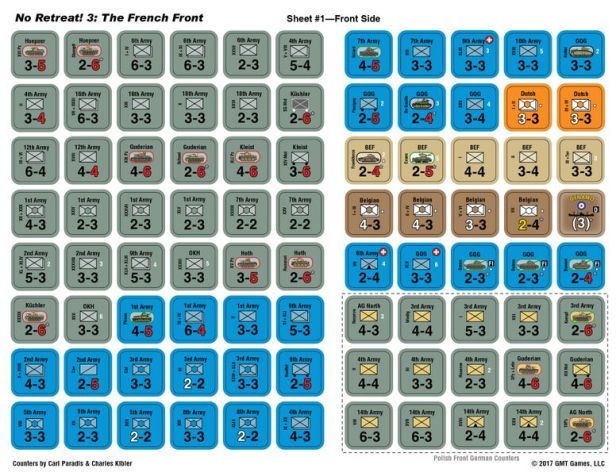
Grant: In The Russian Front, units improved over time. Does this version have a similar element? How does it work?
Carl: No, you do not have that element in the game, given the very short length of time simulated by each turn: 4 days instead of two months! BUT in the Polish Front game there is a mechanism of “Dummy markers” that will show the gradual gain of expertise of both unbloodied armies over the course of the campaign. Some Eliminated units will also be out of the game for good, contrary to other games in the series, given the short time frame.
Grant: I read on GMT’s site the following: “The No Retreat Series card-assisted game systems are there to create on-map puzzles around each hex”. What does this mean?
Carl: See the Event Cards each as a set of “mini-rules” in their own right, without having to read a humongous rulebook. These rules are useable only when the cards are played, and with 80 cards, each with two parts, this gives you 160 “Game rules/events” that can be applied in an infinity of combinations, making the gameplay very dynamic and never twice the same.
Grant: I understand that the Polish Front is a bonus game that introduces new concepts to the system. What does it add?
Carl: As said previously, I added a mechanism showing the gradual gain of expertise of the two relatively “green” armies. Also, I added mini “what-if” historical possibilities to some of the Event Cards, adding a lot of variety to that pretty much “one-sided” battle.

Grant: What intriguing “What If” style hypothetical historical options are added?
Carl: Besides the various Plan Cards of the French Front, and mini “What if” events of the Polish Front, I also added two optional Campaign games that I strongly recommend trying at least once; both the French Front “Hypothetical” 1939 scenario (showing what would possibly have happened if the Germans launched their attack against France early in 1939), and the Polish Front “Comintern” 1939 scenario (simulating the possible event of a Soviet complete reversal of policies). These make for games where both sides are more evenly matched in their global capability to do harm.
Grant: What scenarios are there for each game and how long does each scenario play in both rounds and time?
Carl: There is a “Dunkirk” Scenario for the French Front, Starting at the initial German Breakthrough around Sedan and lasting until the Allies evacuate at Dunkirk. There is also a “Warsaw” scenario for the Polish Front, showing the first German unsuccessful lunge at the Polish capital early in the campaign. Both scenarios last 6 turns (or less) and can be finished in a couple of hours.
Grant: What are you most pleased with about the design?
Carl: The way the game system uncannily simulates what happened in actual history, while also allowing for sudden reversal of fortunes if a player is careless, unlucky, or made bad plans. All the separate “parts” of the design just fell in place just in the right way. This amazes me a lot; I guess I was very lucky, LOL!
Grant: What has changed throughout the game’s development?
Carl: The Playtester’s input was critical for the success of the game. They made me make critical adjustments to the game engine, especially in the way the Combat system simulates the “Strange Defeats” suffered by the Allied armies while keeping the games fun and allowing for reversal of fortune, plus removing some “gimmicky” tactics. Usually when I design a game, I rarely need to make serious adjustments to the initial version. That set of games was different though in that they needed way more trials to make work perfectly. I guess in the end I learned that these are not easy topics to make work well!

Thanks to Carl for his patience with me during this process. I know that he has been acting as designer and developer on this game but has done a fantastic job and I believe that this new addition to the No Retreat! Series will end up being one of my favorites.
The game is currently being offered for pre-order on the GMT Games’ website through their P500 Program for $42.00 at the following link: http://www.gmtgames.com/p-465-no-retreat-3-the-french-and-polish-fronts.aspx
The game currently has 671 orders and has hit “Made the Cut” status but I don’t have any information on its planned release at this point. As you can see from the interview though, the art is nearing final completion and is looking right snappy. Nice work Rodger and Carl!
-Grant

Great questions, review and insights Gents! Thx so much to both Grant & Carl.
LikeLiked by 1 person
Carl is a great interview. Glad you liked it.
LikeLike
Outstanding interview. I can’t wait for this game. I love the series. The games are always stunning.
LikeLike
How about the entire European theater in a single No retreat game from 1939 to 1945?
LikeLike